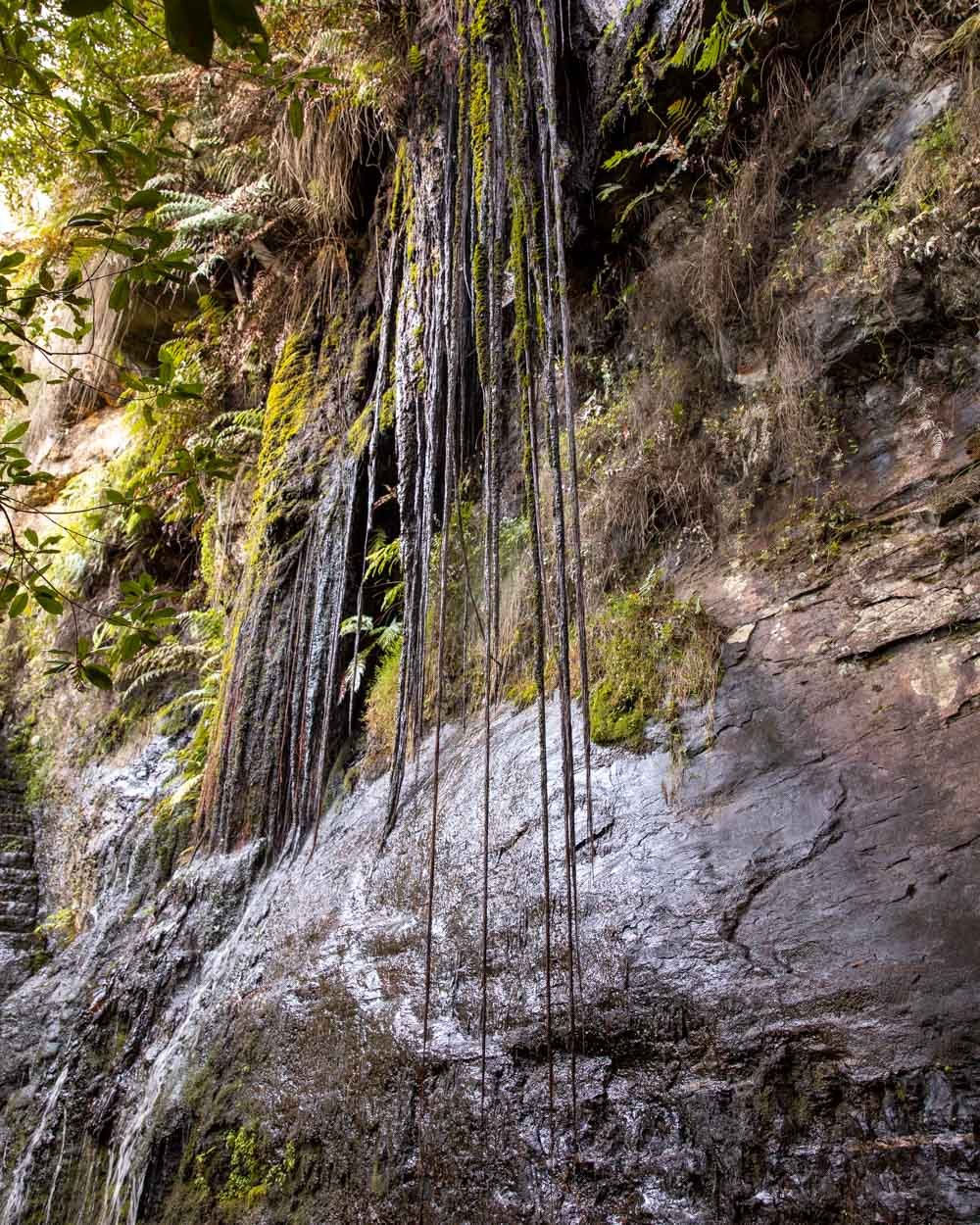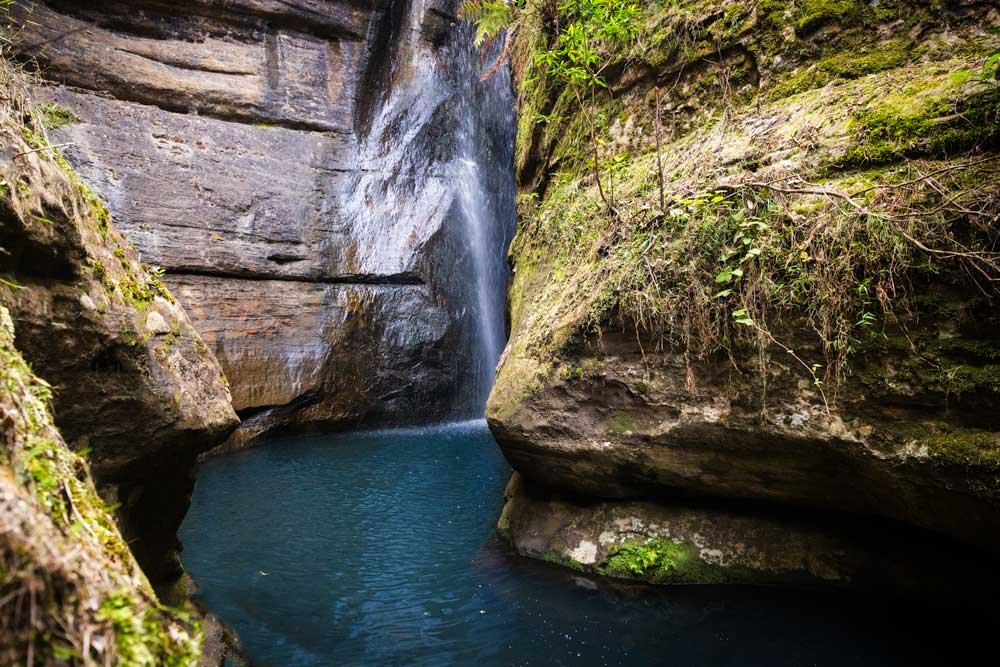Fairy Bower Falls is the most beautiful waterfall in Bundanoon and one of the best in the Southern Highlands. The falls flow into a mossy glen, which is a serene spot to sit and take in the sights and sounds of the forest. Ideally you want to visit after heavy rain, otherwise the falls do become much less powerful, like you can see in our photos - although even then they are still very pretty.
If you’re feeling particularly adventurous you can also visit after dark when you’ll see the falls in a whole new light…
Here’s everything you need to know about visiting Fairy Bower Falls.
The Fairy Bower Falls Walk
The stats
Distance: 2.4km return
Elevation gain: 150m
Difficulty: Easy - moderate
The walk to the bottom of Fairy Bower Falls is all on a well maintained track, but it’s a bit of a climb on the way back out.
Nothing too arduous, but there is little flat track to break it up. You do need to go to the bottom of the falls for a visit here to be worth it, as the lookout on the top of the falls doesn’t offer much in the way of views.
Starting the trail: to the top of the falls
The walk begins heading downhill into the bush along a wide dirt path. It’s relatively steep, but the good terrain makes it an easy descent.
The track holds up well after rain and while you might encounter a little mud, it’s always straightforward to navigate round.
After 250m descending, the path briefly flattens. You’ll quickly come to one of several benches along the track, before hitting several more staircases.
The stairs are well maintained and most have handrails, which is great for when it’s wet and slippery.
Just over 500m into the track you’ll come to a junction. Left will take you to the picnic area and right will take you towards the falls.
After another 100m descending you’ll arrive at a creek crossing, before crossing you can head right and check out the top of the falls, which is just 80m away.
It’s worth taking a look but you can only see the top cascade, not the lower falls, so it’s pretty enough but not a must see.
To the bottom of the falls
After visiting the top of the falls you retrace your steps and cross over the creek. Unless there has been recent flooding it’s a very easy crossing and doesn’t involve wet boots.
The track then heads back into the bush and uphill towards the cliffs. The path heads alongside the cliff wall which offers gorgeous valley views.
From here you have a little more descending to go as you head back into the bush. The path is more uneven here than it’s been to this point, but not too difficult.
There are a few rocky sections and some more uneven steps before you hit a junction, from which it’s just 300m to the bottom of the falls. The trail flattens again as you follow another set of picturesque overhangs.
Although there are some short muddy patches here, most of the track has now been covered in metal grilling which makes it really easy. Roughly 1.2km after leaving the car park you’ll see the bottom of the falls.
From here the path gets rocky and more slippery if wet. You only have to climb down a few rocks, but it does require a little more care.
Fairy Bower Falls
Once you’ve climbed over the rocks you can sit and take it all in. The falls are beautiful and if you’re lucky enough to visit during high flow, spectacular.
However, the setting means that even when the water level is low, it’s still a gorgeous spot. The dense forest is full of ferns and the tall cliff walls make it feel wonderfully secluded. It’s a really tranquil spot to relax in the shade.
Normally you would be able to continue walking beyond the bottom of the falls if you wanted to make a day of it, but currently all other tracks to this point are closed following the 2020 bushfires.
Fairy Bower Falls by night
If you’re up for an adventure after dark you can return to Fairy Bower Falls by night when you’ll discover it has its very own secret glow worm colony! We’ve spent the last few years trying to find hidden glow worms colonies, primarily in the Blue Mountains but we’ve found a few in the Southern Highlands too and thought the habitat at Fairy Bower Falls looked similar.
Happily we discovered lots of glow worms here - although unfortunately the most dense and impressive clusters were along the damp cliff wall just before the bottom of the falls, which is a rockfall area. For this reason you can’t linger here, which makes the viewing experience a little less impressive than at other sites.
You can also see smaller numbers behind the waterfall itself, where they shine like Christmas tree lights, but you can’t get that close to them. You can also view quite a good patch just beside the rockfall sign (stood back from the actual rockfall area) closest to the falls.
If you were able to stand and observe them along the stretch of track where they are most dense, this would be a great glow worm spot, however, as it is, it is more one for enthusiasts.
I love night hiking, so for me it’s always amazing to be in the bush at night, especially if you have a clear starry sky. However, in terms of wow factor, it’s not quite Glow Worm Glen (where there is a proper grotto with a dense number of glow worms that can be viewed easily).
The great thing about the glow worms at Fairy Bower Falls as opposed to Glow Worm Glen (apart from the fact the glen is still closed) is that you will get this experience all to yourself. Although I’m sure locals know about it, it doesn’t appear anywhere else online, so it’s highly unlikely you’ll see other people here, which always makes it feel like more of an adventure.
If you’re a glow worm lover like me and want to see some other hidden dells in the highlands, you’ll find them at Fitzroy Falls and Cascade Falls. We’re hoping the rest of Morton National Park will eventually reopen so we can look for other new spots too.
In terms of hiking in the dark, the good track makes it easy enough. It’s also cooler which is always nice when going back uphill. Just bring a good torch and pay particular attention to the short patches of uneven track.
Taking care of the glow worms and tips for the best experience
Make sure you leave at least an hour after sunset. It can be tempting to head into the bush just after sunset, but you really need full darkness to see the majority of glow worms. You’ll see some earlier but only a fraction of what’s really there. The darker the better. This is especially important at Fairy Bower Falls when there aren’t such dense clusters of glow worms, so you want the ones that are there to appear as bright as possible. For this reason you ideally want low moon light too.
You need to turn all light off to enjoy the glow worms, not just for your eyes to adjust (you’ll need at least five minutes in darkness to see the majority of glow worms - the longer the better) but also because you shouldn’t shine light on glow worms. It can stop them feeding and also encourage them to stop glowing, which in turn ruins the experience for you. It’s really important not to interfere with their natural behaviour, or there could be another disaster like at Helensburgh Tunnel when the colony was nearly wiped out. Please protect them and enjoy the experience as it should be, in darkness.
Glow worm numbers are at their highest in the warmer months and during times of wet weather. For this reason summer is best, and again this is important at Fairy Bower Falls as the numbers are not as great here as at other sites in NSW.
For photography bring a tripod and plan on taking long exposures. You don’t need any light to photograph them.
I’ve used a Sirui for the past 2 years and found it to be brilliant for photographing glow worms - light enough to carry, but sturdy enough for a crisp shot. You can find out all about the one I use by clicking here.
Getting to Fairy Bower Falls
Fairy Bower Falls is located in Morton National Park, a ten minute drive from Bundanoon. When you leave the town and turn into the national park it becomes a dirt road, but it’s generally in good condition and no special clearance is needed. There are potholes but nothing major (at time of writing).
You do need to pay the parks entry fee if you don’t hold an annual NSW national parks pass. Currently the fee is $8 per day for the Bundanoon area.
This post may contain affiliate links, meaning at no additional cost to you, that we will earn a small commission if you click through and decide to make a purchase. This helps towards the costs of running our website. Thanks for your support.
















































